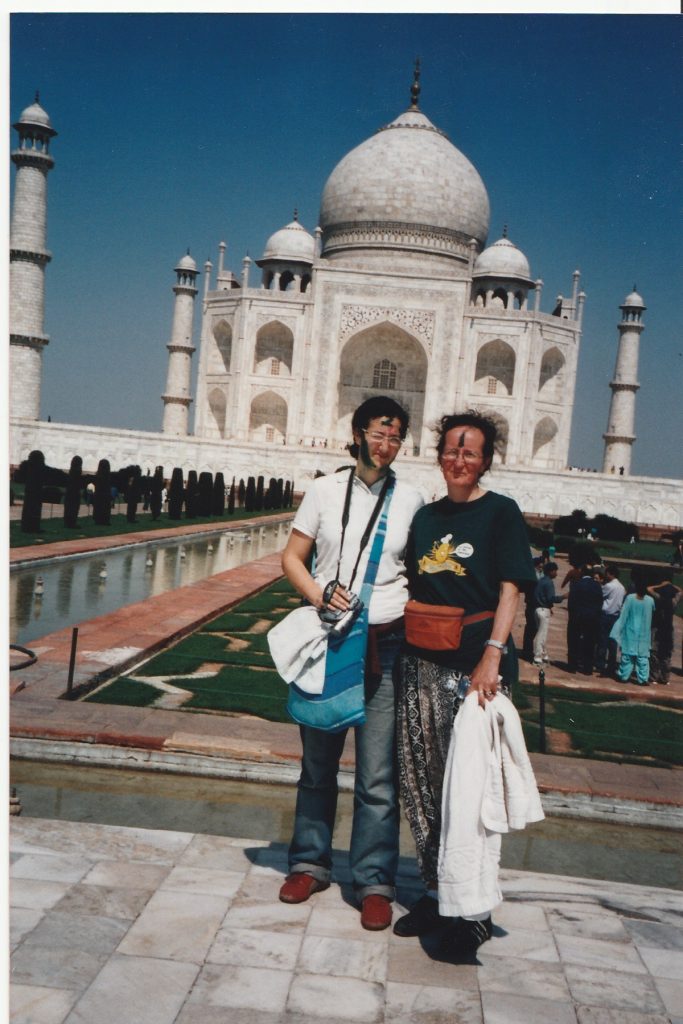Adventure at Taj Mahal, the white Indian wonder

In order to celebrate Holi, we let the guys at the ticket office coloring our faces of green and purple. For me it’s a kind of welcome after our long journey to the one of the seventh world’s wonders.
Adventure at Taj Mahal, the white Indian wonder
We enter through the portal built in red sandstone and surmounted by a large Mughal style dome; from the enormous entrance appears, at the end of a long rectangular garden furrowed by water channels, the candid and compact Taj Mahal. The white marble of its walls seems to reflect the grayness of the sky above Agra, pierced by the four elegant minarets at the corners of the Mausoleum.
The shapes and lines that compose it are on one hand mild and sinuous, on the other hand balanced and sober; it will perhaps be this peculiarity, together with the refinement of the materials and the proportionate measures, that have given the title of one of the 7 wonders of the contemporary world. The reflection of the Taj Mahal in the canals that stretch into the well-kept and green front garden doubles the sense of sublime that the visitor feels in front of the masterpiece of the architect Ustad Amhan Lahauri (not all historians agree).
I like to think that this wonder is the fruit of the powerful love of the Mughal king Shah Jahan for his wife Mumtaz Mahal; died during the birth of their 14th child. It is said that the king’s hair suddenly became all white for the pain of losing his favorite. To honor and keep a promise made to his wife, the king ordered the construction of the Mausoleum, a work that was completed in 20 years of work and saw the use not only of the prized white Makrana marble, but of precious and semi-precious stones, such as jade, jasper, lapis lazuli and sapphires from Afghanistan to China.
King Jahan decided to build the Mausoleum in Agra to facilitate the transport of materials, using the Yamuna river; in New Delhi the cost would in fact have been prohibitive. Among the thousands of artisans who came from various regions of the world, there was also an Italian: Geronimo Veroneo. The work was completed in 1654. The son of King Shan Jahan, at the completion of the work, deposed his father and imprisoned him. Inside the Mausoleum, in addition to the body of his wife Mahal, there is also the sarcophagus with the remains of King Jahan, buried there by his son, against Jahan’s will.
Visit of the site among Indians

We walk happily along the tide path along the canal; strangely the place is full of Indian tourists, while very few Westerners can be seen. As usual, I am stopped every 10 steps for pics together with dozens of guys who ask me to pose with a 34 tooth smile. I don’t reject the continuous requests; but I wish I could have 5 minutes of solitude to admire the Taj Mahal.
Finally I enter through the ogival arch, located above a 7-meter-high rectangular base, a structure similar to the one used for the Humayun Tomb. The white walls are decorated with light floral decorations with hard stones and essential writing of the Koran along the edges of the ogival arches. Inside the sarcophagi of the two spouses are surrounded by a grille that jars with the essentiality of the monument.
We visit the Mosque built in sandstone located in the center of the western side and the Jawab (the guest house), built on the opposite side in order to maintain the symmetrical balance of the complex. I lose myself observing the white decorations of the inner domes that contrast with the red of the sandstone; then I look out over the pointed arches and I admire the perfect proportions of the white Taj Mahal which rises again in front of me.
I wish I could stay here until sunset, but time is running out and taking my mother back by the arm, we head towards the fortress of Agra, reluctantly.
Tips: If you plan a visit, remember that the Taj Mahal is closed on Friday!


Pingback: Agra Fort, the red castle on Yamuna river - Erica Leoni